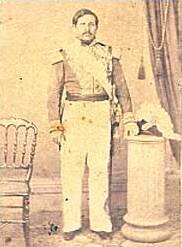Rafael Carrera
|
His Excellency Captain General GCSG Rafael Carrera y Turcios |
|
|---|---|
 |
|
| 8th President of Guatemala | |
|
In office November 6, 1851 – April 14, 1865 |
|
| Chancellor | Juan José de Aycinena y Piñol |
| Preceded by | Mariano Rivera Paz |
| Succeeded by | Pedro de Aycinena y Piñol |
| 1st President of Guatemala | |
|
In office March 21, 1847 – August 17, 1848 |
|
| Preceded by | Inaugural holder |
| Succeeded by | Juan Antonio Martínez |
| 4th State President of Guatemala | |
|
In office December 4, 1844 – March 21, 1847 |
|
| Preceded by | Mariano Paredes |
| Succeeded by | Abolished |
| Personal details | |
| Born |
24 October 1814 Guatemala City, Guatemala |
| Died |
Guatemala 14 April 1865 (aged 50) Guatemala City, República de Guatemala |
| Political party | Conservative |
| Spouse(s) | Petrona Garcia Morales de Carrera |
| Children | José, Francisco, María Mercedes Carrera García |
| Parents | Simón Carrera y Juana Turcios |
| Residence | Mataquescuintla, Guatemala City |
| Occupation | Military |
| Religion | Roman Catholic |
| Signature |  |
| Concordat between the Holy See and the President of the Republic of Guatemala | |
|---|---|
| Created | 1852 |
| Ratified | 1854 |
| Location |
|
| Author(s) | Fernando Lorenzana and Juan José de Aycinena y Piñol |
| Purpose | Through this treaty, Guatemala gave the education of the Guatemalan people to the regular orders of the Catholic Church, committed to respect the ecclesiastical properties and monasteries, authorized mandatory tithing and allowed the bishops to censor what was published in the country. |
| Wyke-Aycinena treaty | |
|---|---|
| Created | April 30, 1859 |
| Ratified | September 26, 1859 |
| Location |
|
| Author(s) | Pedro de Aycinena y Piñol and Charles Lennox Wyke |
| Purpose | Define the borders between the British settlement of Belize and Guatemala. |
José Rafael Carrera Turcios (24 October 1814 Guatemala City – 14 April 1865 Guatemala City) was the president of Guatemala from 1844 to 1848 and from 1851 until his death in 1865, after being appointed President for Life in 1854. During his military career and presidency, new nations in Central America were facing numerous problems: William Walker's invasions, liberal attempts to overthrow the Catholic Church and aristocrats' power, the Civil War in the United States, Mayan uprising in the east, Belize boundary dispute with England, and the wars in Mexico under Benito Juarez. This led to a rise of caudillos, a term that refers to charismatic populist leaders among the indigenous people. Many regional and national caudillos were interested in power for their own gain. Carrera was an exception as he genuinely took the interests of Guatemala's Indian majority to heart.
Backed by the Catholic Church, conservatives of the Aycinena clan led by Juan José de Aycinena y Piñol, and mestizo and indigenist peasants, he dominated politics in the first three decades of Guatemala's independence more than any other individual. He led the revolt against the liberal state government of Mariano Galvez in Guatemala, and then was instrumental in breaking up the Federal Republic of Central America that the liberals wanted. As a result, once the liberals took over power in Guatemala in 1871, Carrera's character and regime were dismissed and demonized, making him look as an illiterate who could not even write his own name and was a puppet of the aristocrats. Over the years, even Marxist writers who wanted to show how the native Guatemalans have been exploited by the elites completely ignored Carrera's interest in them and accused him of racism and being a "little king".
...
Wikipedia
